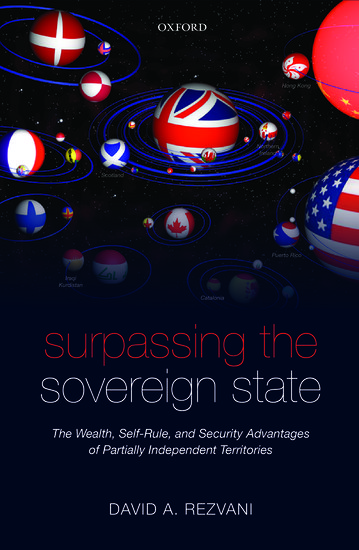This book aims to show that in many regions throughout the world, partially independent territories such as Scotland, Catalonia, and Puerto Rico tend to be wealthier and more secure than their sovereign state counterparts. Gary Wilson feels that the most powerful contribution offered by the book is that it offers a compelling case against secession by demonstrating the various advantages of “partial independence” in relation to independent statehood.
 Surpassing the Sovereign State: The Wealth, Self-Rule, and Security Advantages of Partially Independent Territories. David A. Rezvani. Oxford University Press. 2014.
Surpassing the Sovereign State: The Wealth, Self-Rule, and Security Advantages of Partially Independent Territories. David A. Rezvani. Oxford University Press. 2014.
The role of the sovereign state in international affairs is a subject that is as relevant as ever, as the ever present phenomena of secession and pressures for greater devolution of autonomy on the part of sub-state territorial units continue to gain much media and scholarly attention. The recent Scottish independence referendum is a good indicator of this, the population there rejecting independence although in many cases persuaded by an alternative vision of a Scotland which is afforded much greater autonomy than present while remaining part of the United Kingdom.
This book is a welcome addition to the literature on sovereign states and alternative governmental arrangements, focusing as it does on the much overlooked ‘partially independent territories’ (PITs), those fifty or so territorial units conferred with a considerable degree of autonomy within an existing sovereign state, and their advantages vis- a-vis the alternative of total independence.
The book is divided into three parts, covering the theoretical framework; self-determination; and the economic status, security and dynamics of PITs respectively. The theoretical framework is largely provided by chapter one. Here, the significance of the PIT model is spelled out. The increase in the number of territories adopting this model of governance, their economic relevance (especially in terms of global lending), and their role in international security contribute to a high level of importance. The book’s central arguments are laid out in relation to the existence of PITs, the powers of sovereignty they enjoy, their constitutional nature, and their distinctiveness. Observations are also made upon the causation and evolution of PITs. Chapter two adds to the theoretical framework by making further observations on the advantages of PITs and their manner of evolution.
The four chapters which comprise part two of the book are concerned with exploring the various ways in which PITs exist, or how self-determination is afforded for them within the boundaries of a larger sovereign state. Chapter three looks at the powers possessed by PITs and compares them to other models of government, before the succeeding chapters draw upon particular case studies. Chapter four is concerned with the preservation of civil order through the application of conventional rules within the British context. It draws upon the experience of the British dominions, including Canada, Australia, New Zealand, and South Africa, and traces their status through to the time at which they were granted independence in the earlier part of the twentieth century. It also employs the case study of Northern Ireland to demonstrate the advantages of conventional rules. The case of the US territory of Puerto Rico is the focus of the fifth chapter, which provides a historical overview of its status and gives consideration to a number of different views on its constitutional status. Chapter six is especially interesting, concerned with what is described as “sham federacy”. This label is applied to those instances in which territorial units that are presented as having been endowed with substantial degrees of autonomy or “partial independence” are in fact nothing of the kind. A number of cases in point are discussed here. These include the puppet regimes established in French Indochina, China’s autonomous regions, ethnically separated holding areas in South Africa (such as Bantustan), and the so-called “sovereign Indian Territories” within the United States.

The third and final part of the book sets out to provide empirical support for the claims advanced throughout the book in relation to the various purported advantages of PITs. These concern their relative levels of wealth, security, and degrees of integration. Chapter seven focuses upon weaknesses associated with sovereign statehood, principally in economic and legitimacy terms, before the following chapter goes on to proclaim the wealth and security advantages of partial independence. Various data analyses are utilised at this stage in order to make comparisons between the performance of PITs and those of sovereign states. In chapter nine, the final substantive chapter of the book, an attempt is made to offer some predictions in respect of the dynamics of PITs. It is noted that few entities of this nature have come to an end, the freedom which they enjoy from the burdens attached to sovereign statehood being a key factor in their relative popularity as a mechanism through which self-determination can be exercised by territorial units functioning within the boundaries of a sovereign state. In his detailed concluding chapter, Revzani goes so far as to suggest that the numbers of PITs in existence are only likely to grow. Furthermore, these structures have played an important role in the process of state-building in various locations.
It is worth noting the very informative appendices to be found at the end of the book. These include helpful statistical information detailing examples of PITs throughout history, for example, and add context to the discussion provided throughout the book as well as constituting a useful reference tool.
Without doubt, Surpassing Sovereignty offers an important contribution to the literature in the field. It is a highly original work, offering as it does perspectives on a subject matter that has perhaps surprisingly been exposed to relatively limited academic analysis. While the book will be of particular interest to scholars of international relations and political science, it appeal will also extend to those seeking an enhanced understanding of the dynamics of ‘partial independence’ from perspectives grounded in other disciplines, especially history, law, and economics. Potentially the most powerful contribution offered by the book, particularly in the current climate in which the spectre of secession appears to have taken hold in parts of all regions of the world, is that it offers a compelling case against secession by virtue of the effective manner in which it is able to demonstrate the various advantages of “partial independence” in relation to independent statehood.
This review originally appeared at the LSE Review of Books.
Please read our comments policy before commenting.
Note: This article gives the views of the authors, and not the position of USApp– American Politics and Policy, nor of the London School of Economics.
Shortened URL for this post: http://bit.ly/1E8xyiA
——————————————–
Dr Gary Wilson, PhD LLB (Hons.), FHEA is Senior Lecturer in Law at Liverpool John Moores University. He specialises in collective security, use of force, and issues of secession and self-determination. Read more reviews by Gary.






